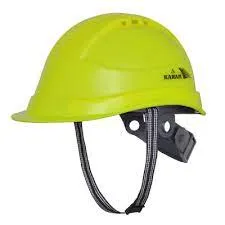White Safety Helmet for Enhanced Protection and Comfort in Work Environments
The Importance of Safety Helmets A Focus on the White Helmet
In various industries, personal protective equipment (PPE) plays a crucial role in safeguarding workers from potential hazards. Among the many types of PPE available, safety helmets stand out as one of the most fundamental pieces of gear. This article delves into the importance of safety helmets, particularly focusing on the symbolic and practical significance of the white safety helmet.
The Role of Safety Helmets
Safety helmets are designed to protect the head from injuries caused by falling objects, collisions, or falls. They are widely used in construction sites, manufacturing plants, mines, and other high-risk work environments. Helmets not only provide physical protection but also serve as a visible reminder of safety protocols on a job site.
Symbolism of the White Helmet
When it comes to color coding safety helmets, white often holds a particular significance. White helmets are commonly worn by site supervisors and safety officers, symbolizing leadership and a higher level of responsibility. This color distinction is not just arbitrary; it serves an essential function in maintaining order and safety on the worksite.
In addition to denoting authority, white helmets also contribute to visibility. In environments where visibility might be compromised due to poor lighting or obstructed views, the bright color of a white helmet makes it easier to identify personnel. This can be crucial during emergency situations or when coordinating complex tasks that require clear communication and visibility among team members.
Regulations and Standards
The use of safety helmets, including white ones, is often governed by strict regulations and standards. Various organizations, such as the Occupational Safety and Health Administration (OSHA) in the United States, have established guidelines for the type of head protection required in different work environments. These regulations specify factors such as material composition, impact resistance, and even the lifespan of helmets.
safety helmet - white

Employers are responsible for ensuring that their workers wear appropriate helmets for their tasks. Regular training on the proper use and maintenance of safety helmets is essential to reinforce their importance and effectiveness. Furthermore, periodic inspections of the helmets can prevent the use of damaged or compromised headgear, which could lead to injuries on the job site.
Advancements in Safety Helmet Design
As technology evolves, so does the design of safety helmets. Modern helmets incorporate advanced materials and ergonomic designs to enhance comfort and protection. Features such as ventilation, adjustable sizes, and moisture-wicking linings ensure that workers remain comfortable while maintaining safety standards.
Moreover, some helmets are now equipped with smart technology, including communication systems and heads-up displays. These innovations allow for improved coordination among team members and provide real-time data about environmental conditions, further ensuring worker safety.
The Psychological Aspect of Wearing Helmets
Wearing a safety helmet, particularly one that signifies authority such as a white helmet, can also have a psychological impact on the workforce. When workers see supervisors and safety officers wearing their helmets, it reinforces the culture of safety and accountability on the site. It encourages all personnel to recognize the importance of following safety protocols and wearing their gear at all times.
Additionally, the act of donning a helmet can psychologically prepare workers for the tasks ahead. It creates a mental association with safety and alerts them to remain vigilant and aware of their surroundings.
Conclusion
In conclusion, safety helmets, especially the white ones, serve much more than just a protective function. They symbolize leadership, enhance visibility, and play a crucial role in fostering a culture of safety at work. With ongoing advancements in helmet design and a continuous commitment to safety regulations, the importance of wearing proper head protection cannot be overstated. For both individual workers and their employers, investing in quality safety helmets is investing in safety, productivity, and ultimately, the well-being of everyone on the job site. Remember, safety starts at the top—with the helmet worn by each individual in the hierarchy, leading by example to create a safer work environment for all.
-
Top HDPE Safety Helmets - Lightweight, Durable Head Protection
NewsAug.01,2025
-
Top AI Safety Clothing with GPT-4 Turbo | Smart Protection
NewsJul.31,2025
-
Face Shield Safety Helmet with GPT-4 Turbo AI Safety
NewsJul.31,2025
-
CE Working Clothing for Construction & Welding Safety
NewsJul.30,2025
-
Premium Safety Helmet with Visor for Construction & Industrial Use
NewsJul.29,2025
-
High-Quality CE Working Clothing for Safety and Construction
NewsJul.29,2025
